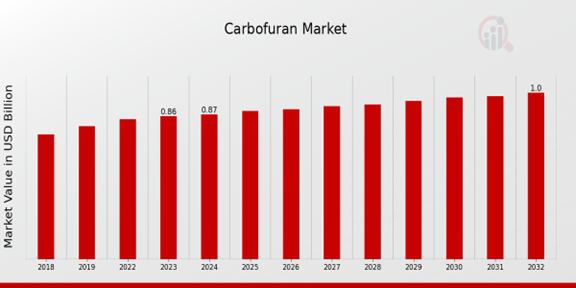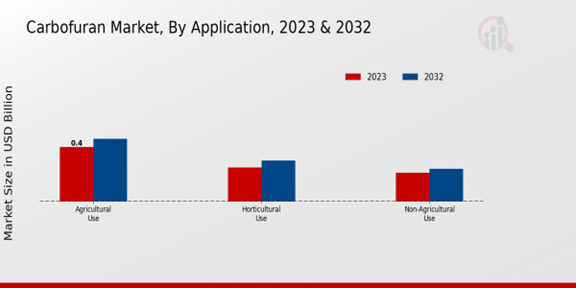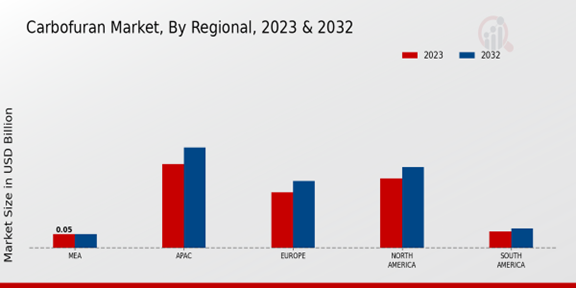Global Carbofuran Market Overview
The carboduran market size was estimated at 0.84 (USD billion) in 2022. The carboduran market is expected to grow from 0.86 (USD billion) in 2023 to 1.0 (USD billion) by 2032. The carboduran market CAGR (growth rate) is expected to be around 1.73% during the forecast period (2024 - 2032).
Key Carbofuran Market Trends Highlighted
The carboduran market is experiencing significant growth driven by increased agricultural activities and the rising demand for high-yield crops. The pest control properties of carbofuran make it an attractive option for farmers looking to protect their crops from a variety of pests and diseases.
Additionally, the expansion of the agricultural sector in emerging economies contributes to the growing usage of this product. Regulatory factors are also shaping the market, with governments implementing stricter regulations aimed at ensuring food safety and environmental compliance, which can affect product availability and usage in different regions.
In this context, manufacturers are under pressure to develop safer and more efficient formulations while adhering to sustainable practices.
There are numerous opportunities for companies operating in the carboduran market to explore. The ongoing research and development efforts focusing on alternative formulations and application methods may lead to new products that deliver improved results with reduced environmental impact.
Moreover, as organic farming continues to gain traction globally, the potential for integrating carbofuran into integrated pest management practices could create new avenues for growth. The increasing consumer awareness regarding food quality and safety encourages manufacturers to invest in innovation to meet regulatory standards and consumer preferences.
Recent trends indicate a shift towards sustainability within the agricultural sector, pushing for eco-friendly alternatives to traditional pesticides. The adoption of precision agriculture technologies is also on the rise, allowing farmers to apply pesticides more efficiently, thus optimizing their use of carbofuran.
These trends suggest a transformative period in the market, where firms that adapt to changing practices and regulations will likely gain a competitive edge, while those that do not may face challenges. Overall, the carboduran market is poised for evolution, pointing towards a more regulated yet growth-oriented future.

Source: Primary Research, Secondary Research, MRFR Database and Analyst Review
Carbofuran Market Drivers
Rising Demand for Agricultural Productivity
The demand for increased agricultural productivity is one of the primary drivers of the carbofuran market. As the population continues to grow, the need for higher food production becomes critical.
Farmers are increasingly looking for effective solutions to protect their crops from pests and diseases that can significantly reduce yield. Carbofuran, a potent carbamate insecticide, plays a key role in pest management by providing effective control over a wide range of economically important pests.
Its unique mode of action allows it to act quickly, making it a preferred choice for many farmers seeking to enhance their crop yields. The necessity for greater agricultural output is further emphasized by the concurrent challenges of climate change, which can adversely affect crop health and productivity.
Additionally, regulatory authorities in various regions are extending support for enhanced agricultural practices that require the integration of effective pest management strategies.
This trend leads to increased adoption of products like carbofuran, resulting in a positive outlook for the carbofuran market. In summary, the quest for improved agricultural productivity driven by population growth and environmental factors sets a solid foundation for the sustained demand and growth of the market as we progress toward 2032.
Technological Advancements in Pest Management
Technological advancements in pest management tools and strategies contribute significantly to the growth of the carbofuran market.
Innovations in application methods, formulation improvements, and integrated pest management practices have made carbofuran more accessible and effective for farmers. This ongoing evolution allows for the optimization of usage, reducing waste and environmental impact while maintaining high efficacy against pests.
Shift Towards Sustainable Agriculture Practices
The growing shift towards sustainable agricultural practices is driving change in the carbofuran market. Farmers are increasingly seeking solutions that not only protect crops but also align with environmentally friendly practices. Carbofuran can be integrated into sustainable pest management strategies, and as regulations evolve, its responsible use is expected to rise, contributing to market growth.
Carbofuran Market Segment Insights
Carbofuran Market Application Insights
The carboduran market is experiencing a notable diversification in its Application segment, which primarily includes Agricultural Use, Horticultural Use, and Non-Agricultural Use.
Agricultural Use dominated the Application segment with a valuation of 0.4 USD billion in 2023, anticipated to rise to 0.46 USD billion in 2032. This segment plays a crucial role in crop protection and pest management, contributing significantly to agricultural productivity.
As a primary application, Agricultural Use showcased majority holding in the sector, making it an essential component for sustaining food production and quality across various regions.
In addition to Agricultural Use, Horticultural Use has established itself as a significant player in the market, with a valuation of 0.25 USD billion in 2023.
This segment is expected to grow steadily to 0.3 USD billion by 2032. Horticultural Use focuses on enhancing the growth and health of flowering and ornamental plants, reflecting the increasing consumer interest in gardening and landscaping.
The rising trend of urban gardening and the demand for ornamental plants have strengthened the position of this segment, showcasing its contributions to aesthetic value and environmental sustainability.
On the other hand, Non-Agricultural Use, valued at 0.21 USD billion in 2023, is projected to increase to 0.24 USD billion in 2032.
While it represents the smallest segment among the three, Non-Agricultural Use potential lies in various applications, including pest control in residential areas and public health sectors. This category is witnessing gradual growth, driven by rising concerns about pests and disease management in non-farming environments.
Overall, the carboduran market segmentation reflects a comprehensive understanding of application areas, addressing the unique needs of the agricultural, horticultural, and non-agricultural sectors, each contributing to the broader market dynamics.
The combination of increasing agricultural productivity, the growth of horticultural activities, and the development in pest control solutions for non-agricultural purposes are critical drivers shaping the market's future, as the community prioritizes sustainable practices along with technological advancements to enhance effectiveness and safety.
The statistics revealed in the carboduran market data lay a foundation for understanding the evolving landscape of this industry, with opportunities for growth emerging from changing consumer preferences and the pressing need for effective pest management solutions across various realms of daily life.

Source: Primary Research, Secondary Research, MRFR Database and Analyst Review
Carbofuran Market Formulation Type Insights
Among these, Granular formulations are widely utilized due to their ease of application and extended-release properties, making them essential for effective pest control in agriculture.
Liquid formulations offer advantages in faster absorption and flexibility in usage, catering to both commercial and residential needs. Water-soluble formulations are gaining traction for their efficiency and reduced environmental impact, appealing to environmentally conscious users.
The increasing adoption of these formulations is driven by their tailored applications across different agricultural practices, contributing to market growth. With such diversity in formulation types, the carbofuran market segmentation illustrates the adaptability of Carbofuran in meeting varied user needs and environmental standards.
The ongoing trends in sustainable agriculture and changing regulatory landscapes present both challenges and opportunities, necessitating innovation and compliance in formulation development to maintain market relevancy.
The strategic focus on formulation advancements will likely shape the future trajectory of the carbofuran market, driven by evolving consumer preferences and agricultural practices.
Carbofuran Market Crop Type Insights
The market segmentation showcases the importance of products tailored for Fruits and Vegetables, Cereal Crops, and Ornamental Plants, each contributing significantly to agricultural productivity and quality.
Fruits and Vegetables often demand effective pest management solutions due to their high perishability, ensuring a robust market presence. Cereal Crops remain a dominant segment, thriving on the necessity for effective crop protection as they account for a large portion of the food supply and require effective management of pest challenges.
Ornamental Plants, while a smaller segment, hold importance for their aesthetic value in landscaping and horticulture, showcasing the versatility of Carbofuran in diverse agricultural practices. The consistent growth in these categories is driven by rising agricultural productivity and the increasing need for effective pest control.
Challenges such as regulatory constraints and environmental concerns may impact usage, but strong opportunities in innovation and sustainable practices are emerging within the carbofuran market, positioning it for gradual expansion in the following years.
Carbofuran Market Packaging Type Insights
The segmentation of the market by Packaging Type reveals important insights, as this area plays a critical role in the distribution and usage of carbofuran.
Bulk packaging is significant due to its efficiency in transporting large quantities, catering primarily to agricultural sectors where mass application of pesticides is prevalent. Small packaging serves the retail sector effectively, appealing to smaller operations and homeowners, thus ensuring ease of access to the product.
Drum packaging is notable for its robust nature, providing secure storage and transportation of carbofuran in larger formats, which is particularly advantageous for larger enterprises. Each of these packaging types holds a vital position within the carboduran market, catering to distinct user needs and preferences, and driving the overall market growth.
Understanding the dynamics of these packaging options is essential for stakeholders seeking to enhance their market strategies based on carbofuran market data and statistics.
Carbofuran Market Regional Insights
The market segmentation within this domain reveals diverse regional performances, with North America valued at 0.25 USD billion, indicating a substantial presence in the industry driven by advanced agricultural practices and regulatory frameworks.
Europe followed closely with a market valuation of 0.20 USD billion, reflecting its commitment to sustainable farming and stringent pesticide regulations. The Asia Pacific region, valued at 0.30 USD billion, demonstrates significant growth potential due to the increasing demand for agricultural productivity, marking it as a critical area for future investments.
In contrast, South America and Middle East Africa, with values of 0.06 USD billion and 0.05 USD billion, respectively, represent smaller yet important markets, indicating emerging opportunities for growth in agricultural inputs.
The carboduran market Statistics show varied dominance across these regions, with North America and Asia Pacific holding significant shares, while opportunities for expansion exist within underrepresented regions, enhancing overall market growth and accessibility.

Source: Primary Research, Secondary Research, MRFR Database and Analyst Review
Carbofuran Market Key Players and Competitive Insights
The carbofuran market is characterized by a dynamic landscape influenced by various factors such as regulatory standards, agricultural practices, and competition among leading industry players. As one of the prominent pesticide products, carbofuran is utilized widely in agriculture to control pests affecting a variety of crops.
The market is shaped by both the demand for effective pest-control solutions and the stringent regulations imposed by environmental agencies, prompting companies to innovate and adapt their product offerings.
A closer look at the competitive dynamics reveals a need for strategic positioning and differentiation among the market participants, which leads to shifting market shares and ongoing product developments.
The players in this market are continuously vying for leadership through technological advancements, regional expansions, and growing their customer base, which contributes to the overall growth and evolution of the carbofuran market.
BASF SE stands out in the carbofuran market due to its robust portfolio of agricultural products and its commitment to sustainable farming practices.
The company leverages its extensive research and development capabilities to create innovative formulations of carbofuran that meet the needs of modern agriculture while adhering to regulatory standards. BASF SE excels in establishing strong partnerships with farmers and agricultural stakeholders, fostering a deeper understanding of the market demands and challenges.
This customer-centric approach allows BASF SE to remain agile and responsive, boosting its credibility and presence in the market. Additionally, with a strong emphasis on sustainability and environmental compliance, BASF SE manages to enhance its brand reputation and appeal to a growing segment of eco-conscious consumers and farmers concerned about chemical usage in agriculture, solidifying its competitive position.
Jiangsu Huifeng Agrochemical has carved out its niche within the carbofuran market through dedicated efforts in product development, competitive pricing, and effective distribution strategies.
The company has made substantial investments in advancing its research capabilities, resulting in improved formulations of carbofuran that are both effective in pest control and compliant with regulatory frameworks.
Jiangsu Huifeng Agrochemical benefits from a well-established supply chain, enabling it to deliver products efficiently across various regions. Its market presence is further enhanced by strategic alliances and collaborations that expand their reach and enhance product availability.
As a result, Jiangsu Huifeng Agrochemical is positioned favorably within the market, driving growth while addressing the evolving needs of the agricultural sector and farmers through its offerings in pest management solutions.
Key Companies in the carbofuran market Include
- BASF SE
- Jiangsu Huifeng Agrochemical
- Zhejiang Jianfeng Chemicals
- Taminco Group
- DuPont de Nemours Inc
- Nufarm Limited
- Syngenta AG
- Shandong Huayang Technology
- Adama Agricultural Solutions Ltd
- Hanfeng Evergreen Inc
- FMC Corporation
- UPL Limited
- Monsanto Company
Carbofuran Market Developments
Recent developments in the carbofuran market have drawn significant attention as regulatory scrutiny intensifies in various regions due to environmental and health concerns.
Many countries, including the United States and several European nations, have tightened restrictions on the use of Carbofuran, citing its potential risks to human health and wildlife. This has led to increased demand for safer, alternative pest control solutions among agricultural producers.
Additionally, growing awareness of sustainable farming practices is compelling stakeholders to seek eco-friendly substitutes, reshaping market dynamics. Innovations in formulation and application methods are also emerging as companies aim to address safety concerns while enhancing efficacy.
As we move toward 2032, the market is anticipated to evolve with these changing regulations and consumer preferences, impacting growth trajectories and overall valuation.
The ongoing discourse regarding food safety and environmental sustainability remains pivotal in shaping future market trends, with research and development playing a crucial role in meeting the anticipated requirements of the evolving agricultural landscape.
Carbofuran Market Segmentation Insights
Carbofuran Market Application Outlook
- Agricultural Use
- Horticultural Use
- Non-Agricultural Use
Carbofuran Market Formulation Type Outlook
- Granular
- Liquid
- Water-Soluble
Carbofuran Market Crop Type Outlook
- Fruits and Vegetables
- Cereal Crops
- Ornamental Plants
Carbofuran Market Packaging Type Outlook
- Bulk Packaging
- Small Packaging
- Drum Packaging
Carbofuran Market Regional Outlook
- North America
- Europe
- South America
- Asia Pacific
- Middle East and Africa
| Report Attribute/Metric |
Details |
| Market Size 2022 |
0.84(USD billion) |
| Market Size 2023 |
0.86(USD billion) |
| Market Size 2032 |
1.0(USD billion) |
| Compound Annual Growth Rate (CAGR) |
1.73% (2024 - 2032) |
| Report Coverage |
Revenue Forecast, Competitive Landscape, Growth Factors, and Trends |
| Base Year |
2023 |
| Market Forecast Period |
2024 - 2032 |
| Historical Data |
2019 - 2023 |
| Market Forecast Units |
USD billion |
| Key Companies Profiled |
BASF SE, Jiangsu Huifeng Agrochemical, Zhejiang Jianfeng Chemicals, Taminco Group, DuPont de Nemours Inc, Nufarm Limited, Syngenta AG, Shandong Huayang Technology, Adama Agricultural Solutions Ltd, Hanfeng Evergreen Inc, FMC Corporation, UPL Limited, Monsanto Company |
| Segments Covered |
Application, Formulation Type, Crop Type, Packaging Type, Regional |
| Key Market Opportunities |
Growing demand for agriculture Increasing pest resistance management Expansion in developing regions Rise in organic farming practices Innovations in formulation technologies |
| Key Market Dynamics |
Regulatory restrictions Environmental concerns Demand from agriculture Competitive substitutes Price volatility |
| Countries Covered |
North America, Europe, APAC, South America, MEA |
Frequently Asked Questions (FAQ) :
The carbofuran market is expected to be valued at 1.0 USD billion by 2032.
The expected CAGR for the carbofuran market from 2024 to 2032 is 1.73.
The Agricultural Use segment is projected to hold the largest market share, valued at 0.46 USD billion by 2032.
By 2032, the market is expected to be valued at 0.29 USD billion in North America, 0.24 USD billion in Europe, 0.36 USD billion in APAC, 0.07 USD billion in South America, and 0.05 USD billion in MEA.
Major players include BASF SE, DuPont de Nemours Inc, FMC Corporation, and Syngenta AG, among others.
The Horticultural Use segment is expected to be valued at 0.3 USD billion by 2032.
Challenges include regulatory scrutiny and competition from alternative pest control solutions.
The Non-Agricultural Use segment is projected to grow to 0.24 USD billion by 2032.
In 2023, the carbofuran market in North America was valued at 0.25 USD billion.
The APAC region is expected to grow and reach an estimated value of 0.36 USD billion by 2032.





























